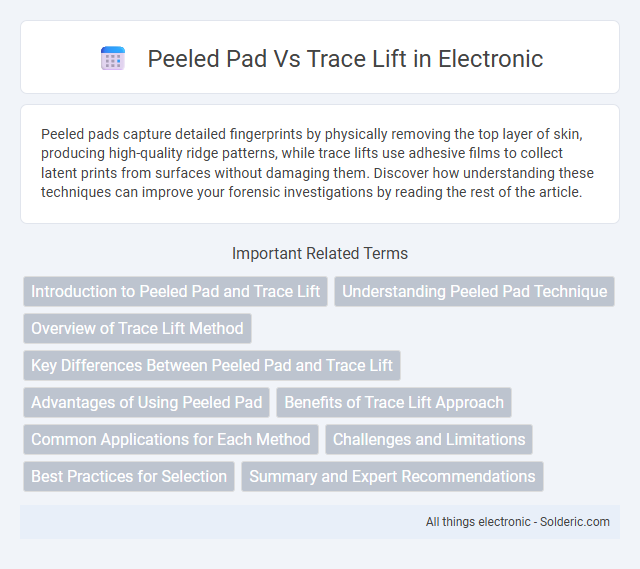Peeled pads capture detailed fingerprints by physically removing the top layer of skin, producing high-quality ridge patterns, while trace lifts use adhesive films to collect latent prints from surfaces without damaging them. Discover how understanding these techniques can improve your forensic investigations by reading the rest of the article.
Comparison Table
| Feature | Peeled Pad | Trace Lift |
|---|---|---|
| Description | Removal of the copper pad from PCB surface | Lifting or detachment of copper trace from the PCB substrate |
| Cause | Mechanical stress, excessive soldering heat | Improper PCB manufacturing, thermal stress, mechanical damage |
| Impact | Breaks electrical connection at component pads | Disrupts signal path along PCB traces |
| Detection | Visual inspection, continuity testing | Visual inspection, electrical testing |
| Repair Difficulty | Moderate - requires rework or pad replacement | High - often requires trace repair or PCB replacement |
Introduction to Peeled Pad and Trace Lift
Peeled pad and trace lift are advanced semiconductor packaging techniques used to enhance microchip performance and reliability. Peeled pad involves removing a portion of the chip's passivation layer to expose pads for direct wire bonding, improving electrical connectivity. Trace lift refers to the process where conductive traces lift from the substrate due to mechanical stress or thermal cycling, potentially causing circuit failure if not properly managed.
Understanding Peeled Pad Technique
The Peeled Pad technique involves carefully removing or lifting the fingerprint ridge skin in a controlled manner to obtain a pristine latent print without smudging. This method ensures higher quality and more detailed ridge patterns compared to Trace Lift, which collects residues often mixed with contaminants. For forensic analysis, the Peeled Pad technique enhances clarity by isolating the actual skin surface, leading to more accurate identification results.
Overview of Trace Lift Method
The trace lift method involves carefully lifting latent fingerprints from surfaces using specialized adhesive materials without damaging the original print. This technique preserves the fine details of ridge patterns, making it highly effective for forensic analysis and comparison. Your ability to recover high-quality prints improves significantly with trace lift, especially on textured or delicate surfaces.
Key Differences Between Peeled Pad and Trace Lift
Peeled pads involve carefully removing the protective layer from a PCB to expose copper for repair or inspection, while trace lifts occur when the copper trace itself detaches or lifts from the substrate, causing electrical discontinuity. The key difference lies in the nature of the defect: peeled pads refer to the loss of the solder mask or protective film, whereas trace lifts indicate physical separation or damage to the conductive path. Understanding whether you are dealing with a peeled pad or a trace lift is crucial for effective PCB rework and restoration strategies.
Advantages of Using Peeled Pad
Peeled pads provide precise, residue-free lifting, ensuring delicate and intricate surfaces remain intact during handling. They offer superior adhesion control compared to trace lifts, reducing the risk of contamination and surface damage. Enhanced accuracy in material recovery makes peeled pads the preferred choice for forensic and scientific applications.
Benefits of Trace Lift Approach
The Trace Lift approach offers precise skin lifting with minimal invasion, promoting natural facial contours without extensive downtime. This method enhances collagen production and skin elasticity, resulting in longer-lasting rejuvenation compared to traditional peeled pad techniques. Patients experience reduced risks of scarring and quicker recovery, making Trace Lift an advantageous option for subtle, yet effective facial rejuvenation.
Common Applications for Each Method
Peeled pads excel in forensic applications requiring non-destructive fingerprint collection from smooth surfaces, preserving ridge detail for further analysis. Trace lift is commonly used to recover latent prints from textured or porous materials, such as fabric or wood, where direct lifting is challenging. Your choice depends on the surface type and the need for preserving the integrity of the fingerprint evidence.
Challenges and Limitations
Peeled pad techniques often face challenges such as adhesive residue contamination and difficulty in achieving precise alignment during the lifting process, which can compromise sample integrity. Trace lift methods are limited by their sensitivity to surface roughness and adhesive strength, affecting the quality and completeness of the lifted trace evidence. Both techniques require careful optimization of parameters to overcome these issues and ensure reliable forensic analysis.
Best Practices for Selection
When choosing between peeled pads and trace lifts in forensic fingerprint collection, consider the surface type and evidence preservation needs; peeled pads excel on curved or textured surfaces, while trace lifts are ideal for flat, fragile prints. Your selection should prioritize the clarity of print details and the likelihood of contamination or distortion. Employing the correct technique based on environmental conditions ensures the highest quality latent fingerprint recovery for analytical accuracy.
Summary and Expert Recommendations
Peeled pads and trace lifts are forensic techniques used to recover latent fingerprints from surfaces; peeled pads involve removing adhesive layers to capture prints, while trace lifts use lifting tapes or gels to transfer prints. Experts recommend selecting peeled pads for delicate or porous materials where traditional lifts may fail, and trace lifts for non-porous, smooth surfaces to preserve ridge details accurately. Your choice should depend on the substrate type and print condition to ensure optimal recovery and evidence integrity.
Peeled pad vs trace lift Infographic

 solderic.com
solderic.com